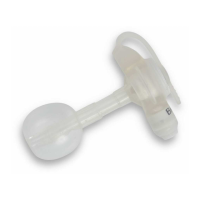
Do you have a question about the Halyard MIC-KEY ENFit and is the answer not in the manual?
| Connector | ENFit |
|---|---|
| Material | Silicone |
| Connection Type | ENFit |
| Balloon Retention | Yes |
| Sterility | Sterile |
| Single Use | Yes |
| Latex Free | Yes |
| Balloon Volume | 3 ml, 5 ml |
| Available Sizes | 12 Fr to 24 Fr |
| External Length | Varies by size |
| Type | Gastrostomy Feeding Tube |
| Product Type | Gastrostomy Tube |
Explains the MIC-KEY* Low-Profile Gastrostomy Feeding Tube for delivering nutrition and medication.
Outlines patients suitable for long-term feeding, low aspiration risk, gastric decompression, or medication delivery.
Lists conditions like ascites, colonic interposition, portal hypertension, peritonitis, and morbid obesity.
Prohibits reuse, reprocessing, or resterilization due to risks of compromised integrity and contamination.
Lists potential issues like skin breakdown, hypergranulation, infection, and leakage associated with the tube.
Details placement methods and warnings regarding gastropexy and stoma sizing for patient safety.
Provides steps for accurate stoma measurement using a device for proper tube sizing and patient comfort.
Instructs on inflating and checking the balloon for leaks and proper symmetry using sterile water.
Guides for inserting the feeding tube over a guidewire and securing the balloon with sterile water.
Details connecting the MIC-KEY* Extension Sets (Bolus or Continuous Feed) to the feeding tube.
Provides instructions for safely removing the feeding tube, including balloon deflation and gentle traction.
Step-by-step guide for replacing the MIC-KEY* feeding tube, including stoma measurement and insertion.
Instructions for flushing, connecting syringes or bags, administering formula, and post-feeding flushing.
Guidance on using extension sets to drain stomach contents for decompression purposes.
Advises on administering medications, including advice on crushing solids and flushing procedures.
Best practices for flushing to prevent clogging and maintain tube patency, avoiding specific irrigants.
Recommendations for flushing volume, technique, and using room temperature tap or sterile water.
Checklist for assessing the patient's condition and the stoma site for signs of issues.